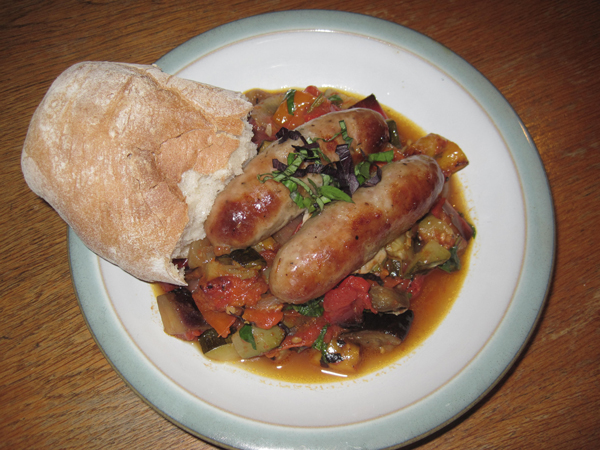Those of you just starting to grow your own vegetables may be wondering what tools you really need. These are my father’s trusty collection. Some of them are over 80 years old and still have their original ash handles. So before you rush out to buy shiny new tools, ask around your family and friends to see if anyone has any spare items, or try local bygones shops or car boot sales. You can also look online, but it is crucial to get the feel of a tool before you buy it – is the handle the correct length and diameter or you? Does it feel right? Does it sound right? (hand-forged spades ‘ring’ when they are struck); how heavy is it? If you are small or not particularly strong, you can buy smaller versions of spades and forks usually described as ‘border’.
Essential Tools
Those of you just starting to grow your own vegetables may be wondering what tools you really need. These are my father’s trusty collection. Some of them are over 80 years old and still have their original ash handles. So before you rush out to buy shiny new tools, ask around your family and friends to see if anyone has any spare items, or try local bygones shops or car boot sales. You can also look online, but it is crucial to get the feel of a tool before you buy it – is the handle the correct length and diameter or you? Does it feel right? Does it sound right? (hand-forged spades ‘ring’ when they are struck); how heavy is it? If you are small or not particularly strong, you can buy smaller versions of spades and forks usually described as ‘border’.
Digging Spade
This spade was given to Dad (new) as a wedding present in 1954. Notice the wear on the bottom corners – you can tell he is right-handed. He had just got his first allotment behind the swimming pool (now a housing estate). If you are buying a new spade, choose the best you can afford. I bought John a stainless steel spade less than 15 years ago and already the plastic handle has broken.


Gardening Which Best Buy was the Joseph Bentley Stainless Steel Digging Spade £26.99. “Suitable for people 5 feet 2 inches to 6 feet tall”. It has a sharp blade – the thinner the blade, the easier the spade pushes into the ground, but it means you have to wear thick-soled boots or shoes to use it comfortably. Also it has a D-shaped handle instead of a T-shaped one, so check it feels comfortable.
See also Burgon and Ball stainless steel digging spade with ash handle.
Link to Burgon and Ball stainless steel digging spade with ash handle (Burgon and Ball website).
Garden Fork
This garden fork is known as a ‘vor-grain prong’ in Wiltshire dialect (vor = four). It is useful for removing deep-rooted weeds such as couch grass and for lifting potatoes. It belonged to Dad’s father. This sort is probably not available as it has very sharp tines.

Which Best Buy for people under about 5 feet 2 inches was the Draper stainless steel garden fork £24 and for taller people the Joseph Bentley Stainless Steel Digging Fork £26.99. Again Burgon and Ball do two sizes: digging fork £29.95 and border fork £27.95.


This is a small fork on a long handle made by Spear & Jackson and given to Dad by my mother. It is useful for cultivating between bedding plants and easier than using a small hand fork.
Hoes
Hoes can be confusing as there are several different sorts designed for different purposes. The one on the left is a Dutch hoe, useful for weeding between rows, but can be tricky to control near plants as you push it away from you.
Burgon & Ball’s Dutch hoe was a Which best buy.

In the middle is a large draw hoe which we think belonged to my maternal grandfather, Victor John (Jack) Brinkworth, another keen vegetable gardener. This has had several new handles over the years. Dad’s tip is to put it in the water butt before use – this makes the wooden handle swell up and stops the head from falling off. This sort of hoe is easier to use close to plants because you draw it towards you (hence ‘draw’ hoe). It is useful for hoeing off weeds and earthing-up potatoes. Draw hoes seem less popular nowadays, but if you look at old photos of agricultural workers this is the sort they will be using, and they would be hoeing for days on end, singling and weeding.
 |
 |
 |
| Dutch hoe |
Draw hoe |
Parsnip hoe |
The little hoe on the right is know in the family as a parsnip hoe: the width of the blade = the distance between the plants within the row, which makes it easier to thin out parsnips evenly. It belonged to my Great-Grandfather Palmer and was given to my gran, Lois Palmer when she was a little girl. It is at least 100 years old. Great Grampy Palmer grew enough carrots and parsnips on his allotments to pay the rent on his cottage.
Soil Rake
Soil rake used for making a seed bed and for removing weeds after hoeing. You can also use the back for making a ‘drill’ (shallow trench) for sowing seeds into.

Which Best Buy was Spear & Jackson Select Stainless Steel. This is lightweight and has a long handle so would suit most people.
Dibber
Finally, you will need a dibber to plant your veg plugs – ours is scored at inch intervals to aid with spacing. Most should be planted with the top of the compost level with the soild, but leeks abd brassicas from planting more deeply.

Hand-made Ash Dibber 10″












